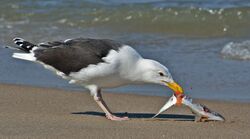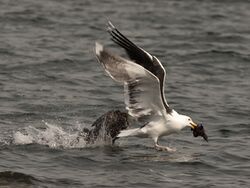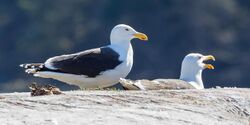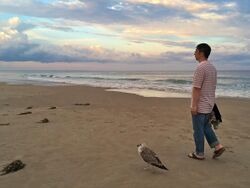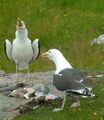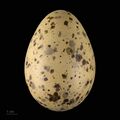Biology:Great black-backed gull
| Great black-backed gull | |
|---|---|
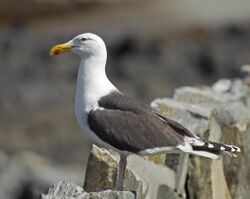
| |
| File:Larus marinus.ogg | |
| Scientific classification | |
| Domain: | Eukaryota |
| Kingdom: | Animalia |
| Phylum: | Chordata |
| Class: | Aves |
| Order: | Charadriiformes |
| Family: | Laridae |
| Genus: | Larus |
| Species: | L. marinus
|
| Binomial name | |
| Larus marinus | |
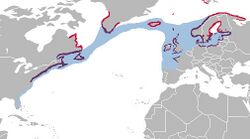
| |
| Distribution across the Northern Hemisphere. Breeding range Year-round range Wintering range
| |
The great black-backed gull (Larus marinus) is the largest member of the gull family. Described by the Cornell Lab of Ornithology as "the king of the Atlantic waterfront",[2] it is a very aggressive hunter, pirate, and scavenger. It breeds on the European and North American coasts and islands of the North Atlantic and is fairly sedentary, though some move farther south or inland to large lakes or reservoirs. The adult great black-backed gull has a white head, neck and underparts, dark grey wings and back, pink legs and yellow bill.
Taxonomy
The great black-backed gull was one of the many species originally described by Carl Linnaeus in his 1758 10th edition of Systema Naturae, and it still bears its original name of Larus marinus.[3] The scientific name is from Latin. Larus appears to have referred to a gull or other large seabird. The specific name marinus means "marine",[4] or when taken together, "sea gull". This predates Linnean taxonomy, as it had been called Larus ingens marinus by Carolus Clusius.[5]
The terms swaabie (from Template:Lang-nrn), baagie and baigie (Template:Lang-nrn, from Old Norse: bak, lit. 'back') are local names from the Shetland Islands.[6][7] Francis Willughby called it the great black and white gull in the 17th century, noting that it was called the swarth-back in the Faroe Islands.[5]
Description
This is the largest gull in the world,[8] considerably larger than a herring gull (Larus argentatus). Only a few other gulls, including Pallas's gull (Ichthyaetus ichthyaetus) and glaucous gull (Larus hyperboreus), come close to matching this species' size.[9] It is 64–79 cm (25–31 in) long with a 1.5–1.7 m (4 ft 11 in–5 ft 7 in) wingspan and a body weight of 0.75–2.3 kg (1 lb 10 oz–5 lb 1 oz).[9][10][11][12][13] In a sample of 2009 adults from the North Atlantic, males were found to average 1,830 g (4 lb 1⁄2 oz) and females were found to average 1,488 g (3 lb 4 1⁄2 oz).[14] Some adult gulls with access to fisheries in the North Sea can weigh up to roughly 2.5 kg (5 1⁄2 lb) and averaged 1.96 kg (4 lb 5 oz).[15] An exceptionally large glaucous gull was found to outweigh any known great black-backed gull, although usually that species is slightly smaller.[9] The great black-backed gull is bulky and imposing in appearance with a large, powerful bill. The standard measurements are: the bill is 5.4 to 7.25 cm (2 1⁄8 to 2 7⁄8 in), the wing chord is 44.5 to 53 cm (17 1⁄2 to 20 3⁄4 in) and the tarsus is 6.6 to 8.8 cm (2 5⁄8 to 3 1⁄2 in).[9][16][17]
The adult great black-backed gull is fairly distinctive, as no other very large gull with blackish coloration on its upper-wings generally occurs in the North Atlantic. In other white-headed North Atlantic gulls, the mantle is generally a lighter gray color and, in some species, it is a light powdery color or even pinkish.[13] It is grayish-black on the wings and back, with conspicuous, contrasting white "mirrors" at the wing tips. The legs are pinkish, and the bill is yellow or yellow-pink with some orange or red near tip of lower bill. The adult lesser black-backed gull (L. fuscus) is distinctly smaller, typically weighing about half as much as a great black-back. The lesser black-back has yellowish legs and a mantle that can range from slate-gray to brownish-colored but it is never as dark as the larger species. A few superficially similar dark-backed, fairly large gulls occur in the Pacific Ocean or in the tropics, all generally far outside this species' range, such as the slaty-backed (L. schistisagus), the western (L. occidentalis) and the kelp gull (L. dominicanus).[9][13]
Juvenile birds of under a year old have scaly, checkered black-brown upper parts, the head and underparts streaked with gray brown, and a neat wing pattern. The face and nape are paler and the wing flight feathers are blackish-brown. The juvenile's tail is white with zigzag bars and spots at base and a broken blackish band near the tip. The bill of the juvenile is brownish-black with white tip and the legs dark bluish-gray with some pink tones. As the young gull ages, the gray-brown coloration gradually fades to more contrasting plumage and the bill darkens to black before growing paler. By the third year, the young gulls resemble a streakier, dirtier-looking version of the adult. They take at least four years to reach maturity, development in this species being somewhat slower than that of other large gulls. The call is a deep "laughing" cry, kaa-ga-ga, with the first note sometimes drawn out in an almost bovid-like sound. The voice is distinctly deeper than most other gull species.[18][19]
Distribution and habitat
This species can be found breeding in coastal areas from the extreme northwest portion of Russia , through much of coastal Scandinavia, on the Baltic Sea coasts, to the coasts of northwestern France , the United Kingdom and Ireland. Across the northern portion of the Atlantic, this gull is distributed in Iceland, the Faroe Islands, southern Greenland and on the Atlantic coasts of Canada and the United States . Though formerly mainly just a non-breeding visitor south of Canada in North America, the species has spread to include several colonies in the New England states and now breeds as far south as North Carolina. Individuals breeding in harsher environments will migrate south, wintering on northern coasts of Europe from the Baltic Sea to southern Portugal, and regularly down to coastal Florida in North America.[20] During the winter in the Baltic Sea, the bird usually stays close to the ice boundary. North of the Åland islands, the sea often freezes all the way from Sweden to Finland , and then the bird migrates to open waters. Exceptionally, the species can range as far south as the Caribbean and off the coast of northern South America.[21]
The great black-backed gull is found in a variety of coastal habitats, including rocky and sandy coasts and estuaries, as well as inland wetland habitats, such as lakes, ponds, rivers, wet fields and moorland. They are generally found within striking distance of large bodies of water while ranging inland. Today, it is a common fixture at refuse dumps both along coasts and relatively far inland. The species also makes extensive use of dredge spoils, which, in the state of New Jersey, are their most prevalent nesting sites.[22] It generally breeds in areas free of or largely inaccessible to terrestrial predators, such as vegetated islands, sand dunes, flat-topped stacks, building roofs and sometimes amongst bushes on salt marsh islands. During the winter, the great black-backed gull often travels far out to sea to feed.[18]
Diet
Great black-backed gulls are opportunistic feeders, apex predators, and are very curious. They will investigate any small organism they encounter and will readily eat almost anything that they can swallow. They get much of their dietary energy from scavenging, with refuse, most provided directly by humans, locally constituting more than half of their diet. The proliferation of garbage or refuse dumps has become a major attractant to this and all other non-specialized gull species in its range.[23][24] A study to investigate how much time they spend foraging at refuse dumps in Massachusetts found great black-backed gulls were only observed actively foraging 19% of their time there, eating less garbage than other common gulls, and spent most of their time roosting or loafing.[25]
Like most gulls, Great Black-backed Gulls regularly capture fish and any fish smaller than itself found close to the surface of the water are potential prey.[18][19] Stomach contents of great black-backed gulls usually show fish to be the primary food.[26][27] On Sable Island in Nova Scotia, 25% of the stomach contents consisted of fish, but 96% of the regurgitations given to young consisted of fish.[28] Similarly, on Great Island in Newfoundland, 25% of the stomach contents were fish but 68% of regurgitants were fish.[27] The most regularly reported fish eaten in Nova Scotia and Newfoundland were capelin (Mallotus villosus), Atlantic cod (Gadus morhua), Atlantic tomcod (Microgadus tomcod), Atlantic mackerel (Scomber scombrus), Atlantic herring (Clupea harengus) and sand lance (Ammodytes hexapterus).[27][28] Other prey often includes various squid, Jonah crabs (Cancer borealis), rock crabs (Cancer irroratus), sea urchins, green crabs (Carcinus maenas), starfish (Asterias forbesi and Asterias rubens) and other echinoderms, crustaceans and mollusks when they come across the opportunity.[29][30] From observations in northern New England, 23% of observed prey was echinoderms and 63% was crustaceans.[29]
Unlike most other Larus gulls, they are highly predatory and frequently hunt and kill any prey smaller than themselves, behaving more like a raptor than a typical larid gull. Lacking the razor-sharp talons and curved, tearing beak of a raptor, the great black-backed gull relies on aggression, physical strength and endurance when hunting. When attacking other animals, they usually attack seabird eggs, nestlings or fledglings at the nest, perhaps most numerously terns,[31] but also including smaller gull species as well as eiders,[32] gannets and various alcids. In Newfoundland and Nova Scotia, 10% of the stomach contents of great black-backed gulls was made up of birds, while a further 17% of stomach contents was made up of tern eggs alone.[27][28] Adult or fledged juveniles of various bird species have also been predaceously attacked. Some fully-fledged or adult birds observed to be hunted in flight or on the ground by great black-backed gulls have included Anas ducks, ruddy ducks (Oxyura jamaicensis), buffleheads (Bucephala albeola), Manx shearwaters (Puffinus puffinus), pied-billed grebes (Podilymbus podiceps), common moorhens (Gallinula chloropus), terns, Atlantic puffins (Fratercula arctica), Dovekie (Alle alle), coots (Fulica ssp.), glossy ibises (Plegadis falcinellus), rock pigeons (Columba livia) and even predatory birds such as hen harriers (Circus cyaneus). When attacking other flying birds, the great black-backed gulls often pursue them on the wing and attack them by jabbing with their bill, hoping to bring down the other bird either by creating an open wound or simply via exhaustion. They may kill healthy adult birds weighing up to at least 750 g (1.65 lb) but take exclusively the small young of larger birds such as common eider (Somateria mollissima) and cormorants.[22][33][34][35][36][37][38] They will also catch flying passerines, which they typically target while the small birds are exhausted from migration and swallow them immediately.[22] Great black-backed gull also feed on land animals, including rats (Rattus ssp.) at garbage dumps, rabbits (Oryctolagus cuniculus) and even sickly lambs (Ovis aries).[18][19][39]
File:Grote mantelmeeuw eet steenloper-4961747.webm Most foods are swallowed whole, including most fish and even other gulls. When foods are too large to be swallowed at once, they will sometimes be shaken in the bill until they fall apart into pieces. Like some other gulls, when capturing molluscs or other hard-surfaced foods such as eggs, they will fly into the air with it and drop it on rocks or hard earth to crack it open. Alternate foods, including berries and insects, are eaten when available. They will readily exploit easy food sources, including chum lines made by boats at sea. They are skilled kleptoparasites who will readily pirate fish and other prey captured by other birds and dominate over other gulls when they encounter them. At tern colonies in coastal Maine, American herring gulls (L. smithsonianus) occasionally also attack nestling and fledgling terns but in a great majority of cases were immediately pirated of their catch by great black-backs.[31] In one observation, an adult great black-back was seen to rob a female peregrine falcon (Falco peregrinus) of a freshly caught gadwall (Anas strepera).[22] In another case, a third-year great black-back was observed fighting an adult female northern goshawk (Accipiter gentilis) off its kill, although the goshawk attempted to strike the gull before leaving.[40] Due to their method of using intimidation while encountering other water and raptorial birds, the species has been referred to as a "merciless tyrant".[19] Naturally, these gulls are attracted to the surface activity of large marine animals, from Atlantic bluefin tuna (Thunnus thynnus) to humpback whales (Megaptera novaeangliae), to capture fish driven to the surface by such creatures.[18][19]
Breeding
This species breeds singly or in small colonies, sometimes in the middle of a Larus argentatus colony. Young adult pair formation occurs in March or April. The following spring the same birds usually form a pair again, meeting at the previous year's nest. If one of the birds doesn't appear, the other bird begins looking for a new mate. Usually a single bird does not breed in that season.
They make a lined nest on the ground often on top of a rocky stack, fallen log or other obstructing object which can protect the eggs from the elements. Usually, several nest scrapes are made before the one deemed best by the parents is selected and then lined with grass, seaweed or moss or objects such as rope or plastic. When nesting on roofs in urban environments, previous year's nests are often reused over and over again. The female lays usually three eggs sometime between late April and late June. When only two eggs are found in a nest, the reason is almost always that one egg, for one reason or another, has been destroyed. It takes around one week for the female to produce the three eggs, and the incubation doesn't begin until all three eggs are laid. Hence all three chicks are hatched the same day. The birds are usually successful in bringing up all the three chicks.
The eggs are greenish-brown with dark speckles and blotches. Both parents participate in the incubation stage, which lasts for approximately 28 days. During this time, the birds attempt to avoid being noticed and stay silent. The breeding pair are devoted parents who both take shifts brooding the young, defending the nest and gathering food. Young great black-backed gulls leave the nest area at 50 days of age and may remain with their parents for an overall period of around six months, though most fledglings choose to congregate with other immature gulls in the search for food by fall. These gulls reach breeding maturity when they obtain adult plumage at four years, though may not successfully breed until they are six years old.[18]
Longevity and mortality
This is a relatively long-living bird. The maximum recorded age for a wild great black-backed gull is 27.1 years.[41] This species is rarely kept in captivity, but domestically kept European herring gulls have been known to live for over 44 years and generally larger birds can outlive smaller ones.[42] Mortality typically occurs in the early stages of life, when harsh weather conditions (including flooding) and starvation can threaten them, as well as predators. Chicks and eggs are preyed on by crows (Corvus ssp.), cats (Felis catus), other gulls, raccoons (Procyon lotor) and rats (Rattus ssp.). The bald eagle (Haliaeetus leucocephalus),[43] white-tailed eagle (H. albicilla) and golden eagle (Aquila chrysaetos) are the only birds known to habitually predate healthy, fully grown great black-backed gulls.[44] In one study from Norway , great black-backed gulls were the fifth highest frequency prey item for white-tailed eagles and gulls are prone to mobbing these huge eagles.[45][46] The great black-backed gull has also been observed engaging in aerial combat with bald eagles, attacking the eagles and chasing them away.[47] A great skua (Stercorarius skua) was filmed in Scotland unsuccessfully attempting to kill a second or third year great black-backed gull.[48] In Norway , great black-backed gulls have also been reported to fall prey to Eurasian eagle-owls (Bubo bubo).[49] Killer whales (Orcinus orca) and sharks also reportedly prey upon adult and juvenile birds at sea. In some biomes, where large eagles are absent the great black-backed gull may be considered the apex predator.[19]
Status
Historically, the great black-backed gull was harvested for its feathers, which were used in the hat-making trade, and this species was extirpated from large parts of its range as a result of this exploitation.[18] Today, however, its adaptability to human presence and the use of urban environments as artificial nesting sites has resulted in the great black-backed gull rapidly increasing in number and range. It is now a widespread and abundant species in its range and its numbers have increased to such high levels in some areas that it is often seen as a pest species, especially near airports where it risks collisions with airplanes, and in some coastal areas where it sometimes outcompetes or hunts rarer seabirds, such as Atlantic puffins, possibly resulting in conservationist intervention.[18] The increase and expansion of great black-backed gulls has been attributed to increasing winter fishery activities in the North Sea.[15] Although there are no known major threats to the great black-backed gull, high levels of toxic pollutants, which are ingested with contaminated prey, are often found in individuals and eggs, reducing reproductive success. Breeding is also interrupted by human disturbance, which can lead to eggs being abandoned, leaving them vulnerable to exposure and predation.
Gallery
References
- ↑ BirdLife International (2018). "Larus marinus". IUCN Red List of Threatened Species 2018: e.T22694324A132342572. doi:10.2305/IUCN.UK.2018-2.RLTS.T22694324A132342572.en. https://www.iucnredlist.org/species/22694324/132342572. Retrieved 29 August 2023.
- ↑ "Great Black-backed Gull Overview, All About Birds, Cornell Lab of Ornithology". https://www.allaboutbirds.org/guide/Great_Black-backed_Gull/overview.
- ↑ Linnaeus, C. (1758) (in la). Systema naturae per regna tria naturae, secundum classes, ordines, genera, species, cum characteribus, differentiis, synonymis, locis. Tomus I. Editio decima, reformata. v.1. Holmiae [Stockholm]: (Laurentii Salvii). p. 136. https://biodiversitylibrary.org/page/727041.
- ↑ Jobling, James A (2010). The Helm Dictionary of Scientific Bird Names. London: Christopher Helm. pp. 219, 242. ISBN 978-1-4081-2501-4. https://archive.org/details/Helm_Dictionary_of_Scientific_Bird_Names_by_James_A._Jobling.
- ↑ 5.0 5.1 Willughby, Francis (1681). The ornithology of Francis Willughby of Middleton in the county of Warwick, esq. .... London, United Kingdom: A.C. for John Martyn. pp. 344. https://www.biodiversitylibrary.org/page/41442143.
- ↑ Jakobsen, Jakob (1928–1932). An etymological dictionary of the Norn language in Shetland (2 volumes). Printed by S. L. Møller, Copenhagen. Foreword by Anna Horsböl, née Jakobsen. Originally published in Danish as Etymologisk ordbog over det norröne sprog på Shetland. Reprinted Lerwick: The Shetland Folk Society, 1985. (1st ed.). Shaftesbury Avenue, London: David Nutt (A. G. Berry). pp. 24, 918. https://archive.org/details/anetymodictofthenornlanginshet. Retrieved 2020-03-24.
- ↑ Swann, H. Kirke (1913). A dictionary of English and Folk-names of British Birds. London: Witherby and Co.. p. 9. https://archive.org/stream/dictionaryofengl00swan#page/8/mode/2up.
- ↑ Richman, Talia (January 1, 2018). "Bird count for than just a game". The Baltimore Sun (Tronc): p. 1. https://www.newspapers.com/clip/23148413/bird_count_more_than_just_game/.
- ↑ 9.0 9.1 9.2 9.3 9.4 Olsen, Klaus Malling; Larsson, Hans (2004). Gulls: of North America, Europe, and Asia. Princeton University Press. ISBN 978-0691119977. OCLC 869139988. https://archive.org/details/gullsofnorthamer0000olse.
- ↑ Good, Thomas P. (1998). Poole, A.. ed. "Great Black-backed Gull (Larus marinus)". The Birds of North America Online. doi:10.2173/bna.330. http://bna.birds.cornell.edu/bna/species/330.
- ↑ Strøm, Hallvard. "Great Black-backed Gull". http://npweb.npolar.no/english/arter/svartbak.
- ↑ "Great Black-backed Gull". http://www.arkive.org/great-black-backed-gull/larus-marinus/.
- ↑ 13.0 13.1 13.2 Harrison, Peter (1991). Seabirds: An Identification Guide. Houghton Mifflin Harcourt. ISBN 978-0-395-60291-1.
- ↑ Dunning, John B. Jr., ed (1992). CRC Handbook of Avian Body Masses. CRC Press. ISBN 978-0-8493-4258-5.
- ↑ 15.0 15.1 Hüppop, O.; Wurm, S. (2000). "Effects of winter fishery activities on resting numbers, food and body condition of large gulls Larus argentatus and L. marinus in the south-eastern North Sea". Marine Ecology Progress Series 194: 241–247. doi:10.3354/meps194241. Bibcode: 2000MEPS..194..241H.
- ↑ Coues, Elliott (1903). Key to North American Birds: Containing a Concise Account of Every Species of Living and Fossil Bird at Present Known from the Continent North of the Mexican and United States Boundary, Inclusive of Greenland and Lower California, with which are Incorporated General Ornithology ... and Field Ornithology .... D. Estes. pp. 986. https://books.google.com/books?id=hYUxAQAAMAAJ&pg=PA986. Retrieved 23 August 2012.
- ↑ Good, Thomas P. (1998). Poole, A.. ed. "Great Black-backed Gull (Larus marinus)". The Birds of North America Online. doi:10.2173/bna.330. http://bna.birds.cornell.edu/bna/species/330/articles/measurements. Retrieved 19 December 2012.
- ↑ 18.0 18.1 18.2 18.3 18.4 18.5 18.6 18.7 "Great black-backed gull". All About Birds. Cornell Lab of Ornithology. http://www.allaboutbirds.org/guide/Great_black-backed_gull/id.
- ↑ 19.0 19.1 19.2 19.3 19.4 19.5 del Hoyo, J.; Elliot, A.; Sargatal, J. (1996). Handbook of the Birds of the World. 3. Barcelona: Lynx Edicions. ISBN 978-84-87334-20-7.
- ↑ Duncan, Robert A. (1981). "The Great Black-backed Gull: a Gulf Coast status review". American Birds 35 (2). http://sora.unm.edu/sites/default/files/journals/nab/v035n02/p00233-p00234.pdf.
- ↑ "Species factsheet: Larus marinus". BirdLife International. http://www.birdlife.org/datazone/species/factsheet/22694324.
- ↑ 22.0 22.1 22.2 22.3 Sutton, Pat; Sutton, Clay (2006). Birds and Birding at Cape May: What to See and When and Where to Go. Stackpole Books. ISBN 978-0811731348.
- ↑ Wells, J.V. (1994). "Correlates of the distribution and abundance of wintering gulls in Maine". Journal of Field Ornithology 65 (3): 283–294.
- ↑ Zufelt, Kirk (15 November 2009). "7 species of Gulls simultaneously at the Landfill". http://larusology.blogspot.com/2009/11/7-species-of-gulls-simultaneously-at.html.
- ↑ Cavanagh, P.M. (1992). Population dynamics, foraging ecology and management of gulls on Monomoy NWR (PhD Thesis). University of Massachusetts, Amherst.
- ↑ Threlfall, W. (1968a). "The food of three species of gull in Newfoundland". Canadian Field-Naturalist 82: 176–180.
- ↑ 27.0 27.1 27.2 27.3 Pierotti, R. (1979). The reproductive behaviour and ecology of the Herring Gull in Newfoundland (PhD Thesis). Halifax, Nova Scotia: Dalhousie University.
- ↑ 28.0 28.1 28.2 Lock, A. (1973). A study of the breeding biology of two species of gulls in Nova Scotia (PhD Thesis). Halifax, Nova Scotia: Dalhousie University.
- ↑ 29.0 29.1 Good, T.P. (1992). Herring Gulls Larus argentatus and Great Black-backed Gulls Larus marinus as rocky-shore predators: patterns and implications for intertidal communities (Master's Thesis). University of New Hampshire, Durham.
- ↑ Dumas, J.V. (1996). Factors affecting the abundance and distribution of the green sea urchin (Strongylocentrotus droebachiensis) in rocky intertidal pools of New England (PhD Thesis). Philadelphia, PA: Drexel University.
- ↑ 31.0 31.1 Donehower, C.E.; Bird, D.M.; Hall, C.S.; Kress, S.W. (2007). "Effects of gull predation and predator control on tern nesting success at Eastern Egg Rock, Maine". Waterbirds 30 (1): 29–39. doi:10.1675/1524-4695(2007)030[0029:EOGPAP2.0.CO;2].
- ↑ Donehower, C.E.; Bird, D.M. (2008). "Gull Predation and Breeding Success of Common Eiders on Stratton Island, Maine". Waterbirds 31 (3): 454–462. doi:10.1675/1524-4695-31.3.454. http://www.projectpuffin.org/pdfs/2008_donehower_and_bird_eider_success.pdf.
- ↑ Donehower, C.E. (2006). "Likely Predation of Adult Glossy Ibis by Great Black-backed Gulls". The Wilson Journal of Ornithology 118 (3): 420–422. doi:10.1676/05-113.1. http://www.projectpuffin.org/pdfs/2006_Donehower_ibis_pred_by_GBBG.pdf.
- ↑ Yates, Barry. "Moorhen Murder". RX Wildlife. http://rxwildlife.org.uk/2005/09/26/moorhen-murder/.
- ↑ Tarry, Emmalee. "Sea Bird Colonies of Ireland, Wales and Scotland". New England Seabirds. http://www.neseabirds.com/Europe/WanderingEurope.htm.
- ↑ Russell, J., & Montevecchi, W. A. (1996). Predation on adult Puffins Fratercula arctica by Great Black‐backed Gulls Larus marinus at a Newfoundland colony. Ibis, 138(4), 791-794.
- ↑ Munro, J., & Bédard, J. (1977). Gull predation and creching behaviour in the common eider. The Journal of Animal Ecology, 799-810.
- ↑ Kury, C. R., & Gochfeld, M. (1975). Human interference and gull predation in cormorant colonies. Biological Conservation, 8(1), 23-34.
- ↑ "Great black-backed gull". https://www.wildlifetrusts.org/wildlife-explorer/birds/seabirds/great-black-backed-gull.
- ↑ Karlsen, Rune Sveinsgjerd (27 January 2012). "Den tøffe måka og hauken" (in no). Natur i Bilder. http://naturibilder.blogspot.no/2012/01/den-tffe-maka-og-hauken.html.
- ↑ "Longevity, ageing, and life history of Larus marinus". http://genomics.senescence.info/species/entry.php?species=Larus_marinus.
- ↑ Wood, Gerald (1983). The Guinness Book of Animal Facts and Feats. Guinness Superlatives. ISBN 978-0-85112-235-9. https://archive.org/details/guinnessbookofan00wood.
- ↑ Marcotte, Bob (24 June 2011). "A marked decline in Great Black-backed Gulls". http://blogs.democratandchronicle.com/birds/?p=339.
- ↑ Good, T. P.. 1998. "Great Black-backed Gull (Larus marinus)", version 2.0. In The Birds of North America (A. F. Poole and F. B. Gill, Editors). Cornell Lab of Ornithology, Ithaca, NY, USA.
- ↑ Vrezec, A. (2016). Prehranska niša orla belorepca (Haliaeetus albicilla) z idejnim predlogom za izvedbo dodatnega krmljenja vrste v širši okolici Reškega jezera pri Kočevski reki. Poročilo v okviru projekta LIFE Kočevsko (LIFE13 NAT/SI/000314), Ljubljana.
- ↑ Willgohs, J. F. (1984). Havørn i Norge: Næring, Forplantningsøkologi, Konkurrenter Og Fiender. Direktoratet for vilt og ferskvannsfisk. Direktoratet for vilt og ferskvannsfisk. 84 pgs.
- ↑ "The Auk". https://academic.oup.com/auk/OUP/RunPdfHandler?journal=auk&volume=92&issue=3&page=584&multimediaId=28126802.
- ↑ Great Skua vs. GBB Gull, Shetland. YouTube. 9 August 2009. Archived from the original on 2021-12-12. Retrieved 19 December 2012.
- ↑ Hagen, Yngvar (1950). "Noen iakttagelser over hubro (Bubo bubo L.) i Rogaland" (in no). Stavanger Museums årbok 60: 93–110. http://www.museumstavanger.no/Portals/48/Biblioteket/Aarbokartikler%201950-1959/1950%20Noen%20iakttagelser%20over%20hubro%20(Bubo%20Bubo%20L.)%20i%20Rogaland.pdf. Retrieved 2017-05-22.
Further reading
- Field Guide to the Birds of North America. National Geographic. 2002. ISBN 978-0-7922-6877-2.
- Handbook of the Birds of the World. 3. Barcelona: Lynx Edicions. 1992. ISBN 978-84-87334-10-8.
- Sibley, David Allen (2000). The Sibley Guide to Birds. New York: Knopf. p. 483. ISBN 978-0-679-45122-8. https://archive.org/details/sibleyguidetobir00sibl_0/page/483.
- Olsen, Klaus Malling; Larsson, Hans (2004). Gulls of Europe, Asia and North America. A&C Black. ISBN 978-0-7136-7087-5.
External links
- "Larus marinus". Avibase. https://avibase.bsc-eoc.org/species.jsp?lang=EN&avibaseid=.
- "Great black-backed gull media". Internet Bird Collection. http://www.hbw.com/ibc/species/great-black-backed-gull-larus-marinus.
- Great black-backed gull photo gallery at VIREO (Drexel University)
Wikidata ☰ Q26629 entry
 |

